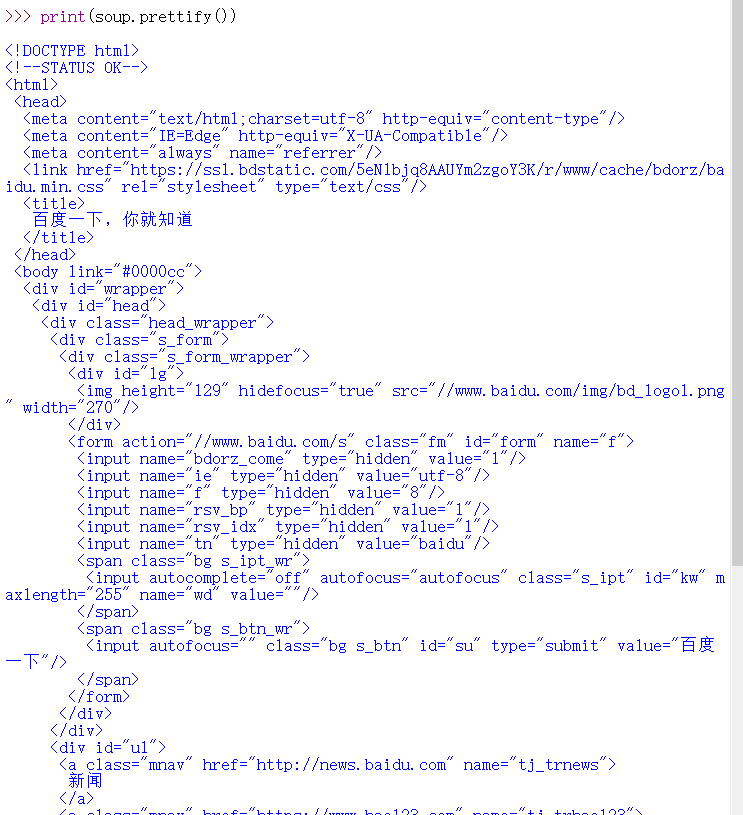BeautifuSoup入门
Beautiful Soup库是一个解析HTML文件的优秀的库。
解析,遍历,维护“标签树”的功能库。
安装:
pip安装: pip install beautifulsoup4
conda安装 conda install beautifulsoup4
导入:
from bs4 import BeautifulSoup
对BeautifulSoup类的理解:

一个BeautifulSoup对象对应一个HTML/XML文档的全部内容。
soup = BeautifulSoup(open('D://demo.html'),'html.parser') soup2 = BeautifulSoup('<html>data</html>','html.parser') r= requests.get('www.baiidu.com') soup3 = BeautifulSoup(r.text,'html.parser')
对soup对象调用prettify()可以将HTML按格式展示出来,方便阅读
import requests from bs4 import BeautifulSoup r = requests.get('https://www.baidu.com/') r.encoding = r.apparent_encoding demo = r.text soup = BeautifulSoup(demo, 'html.parser') print(soup.prettify())
以baidu为例

打印出来的其实就是baidu的源代码。
后面跟的 html.parser 是指定用bs4的HTML解析器对网页解析, 可以指定别的解析器

BeautifulSoup类的基本元素:
| 基本元素 | 说明 |
| Tag | 标签,最基本的信息组织单元,分别用<>和</>标明开头和结尾 |
| Name | 标签的名字,<p>...</p>的名字是‘p’,格式:<tag>.name |
| Attributes | 标签的属性,字典形式组织,格式:<tag>.attrs |
| NavigableString | 标签内非属性字符串,<>...</>中的字符串,格式:<tag>.string |
| Comment | 标签内字符串的注释部分,一种特殊的Comment类型 |

以 http://python123.io/ws/demo.html 为例
>>> r = requests.get('http://python123.io/ws/demo.html') >>> demo=r.text >>> soup = BeautifulSoup(demo, 'html.parser') >>> print(soup.prettify()) <html> <head> <title> This is a python demo page </title> </head> <body> <p class="title"> <b> The demo python introduces several python courses. </b> </p> <p class="course"> Python is a wonderful general-purpose programming language. You can learn Python from novice to professional by tracking the following courses: <a class="py1" href="http://www.icourse163.org/course/BIT-268001" id="link1"> Basic Python </a> and <a class="py2" href="http://www.icourse163.org/course/BIT-1001870001" id="link2"> Advanced Python </a> . </p> </body> </html>
Tag标签
> >>> tag = soup.a >>> tag <a class="py1" href="http://www.icourse163.org/course/BIT-268001" id="link1">Basic Python</a> >>> soup.body <body> <p class="title"><b>The demo python introduces several python courses.</b></p> <p class="course">Python is a wonderful general-purpose programming language. You can learn Python from novice to professional by tracking the following courses: <a class="py1" href="http://www.icourse163.org/course/BIT-268001" id="link1">Basic Python</a> and <a class="py2" href="http://www.icourse163.org/course/BIT-1001870001" id="link2">Advanced Python</a>.</p> </body> >>>
Tag的name(返回字符串):
>>> tag.name 'a' >>> soup.body.name 'body' >>> soup.a.parent.name 'p' >>> soup.a.parent.parent.name 'body'
Tag的attrs(返回字典类型,一个tag可以有多个属性):
>>> tag = soup.a >>> tag <a class="py1" href="http://www.icourse163.org/course/BIT-268001" id="link1">Basic Python</a> >>> tag.attrs {'href': 'http://www.icourse163.org/course/BIT-268001', 'class': ['py1'], 'id': 'link1'} >>> tag.attrs['href'] 'http://www.icourse163.org/course/BIT-268001'
Tag的NavigableString(可以跨越多个层次,留意p标签)
>>> soup.a <a class="py1" href="http://www.icourse163.org/course/BIT-268001" id="link1">Basic Python</a> >>> soup.a.string 'Basic Python' >>> soup.p <p class="title"><b>The demo python introduces several python courses.</b></p> >>> soup.p.string 'The demo python introduces several python courses.' >>> type(soup.a.string) <class 'bs4.element.NavigableString'>
Tag的Comment(注释类,用type区分于NavigableString):
>>> newsoup = BeautifulSoup('<b><!--This is a comment--></b><a>This is not a comment</a>', 'html.parser') >>> newsoup.b.string 'This is a comment' >>> type(newsoup.b.string) <class 'bs4.element.Comment'> >>> newsoup.a.string 'This is not a comment' >>> type(newsoup.a.string) <class 'bs4.element.NavigableString'>
标签树的遍历:
下行遍历
| 属性 | 说明 |
| .contents | 子节点的列表,将<tag>所有的儿子节点存入列表 |
| .children | 子节点的迭代类型,与.content类似,用于循环遍历儿子节点 |
| .descendants | 子孙节点的迭代类型,包含所有子孙节点,用于循环遍历 |
上行遍历
| 属性 | 说明 |
| .parent | 节点的父亲标签 |
| .parents | 节点先辈标签的迭代类型,用于循环遍历先辈节点 |
平行遍历
| 属性 | 说明 |
| .next_sibling | 返回按照HTML文本顺序的下一个平行节点标签 |
| .previous_sibling | 返回按照HTML文本顺序的上一个平行节点标签 |
| .next_silblings | 迭代类型,返回按照HTML文本顺序的后续所有平行节点标签 |
| .previous_siblings | 迭代类型,返回按照HTML文本顺序的前续所有平行节点标签 |
bs4库的编码
bs4库将任何HTML输入都变成utf-8编码
基于bs4库的HTML内容查找方法
<>.find_all(name, attrs, recursive, string, **kwargs)
-
- name :对标签名称的检索字符串
- attrs :对标签属性值的检索字符串,可标注属性检索
- recursive :是否对子孙全部检索,默认True
- string :<>...</>中字符穿区域的检索字符串
<tag>(..) 等价与 <tag>.fing_all(..)
soup(..) 等价于 soup.find_all(..)
扩展方法
| 方法 | 说明 |
| <>.find() |
搜索且只返回一个结果,同.find_all()参数 |
|
<>.find_parents() |
在先辈节点中搜索,返回列表类型,同.find_all()参数 |
| <>.find_parent() |
在先辈节点中返回一个结果,同.find()参数 |
| <>.find_next_siblings() |
在后续平行节点中搜索,返回列表类型,同.find_all()参数 |
| <>.find_next_sibling() |
在后续平行节点中返回一个结果,同.find()参数 |
| <>.find_previous_siblings() |
在前序平行节点中搜索,返回列表类型,同.find_all()参数 |
| <>.find_previous_sibling() | 在前序平行节点中返回一个结果,同.find()参数 |



